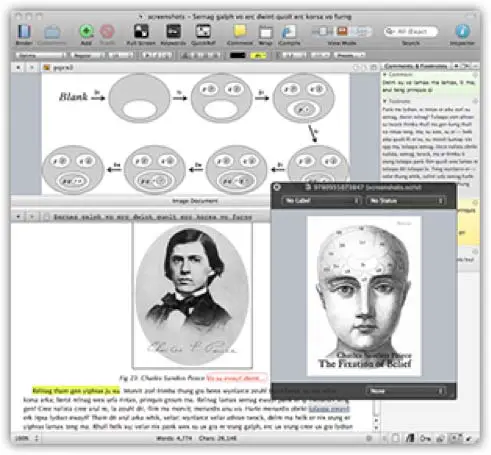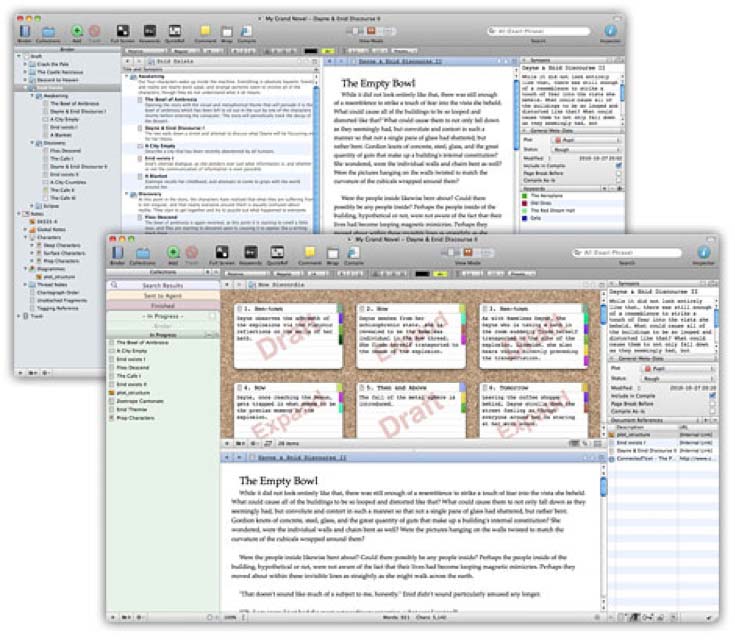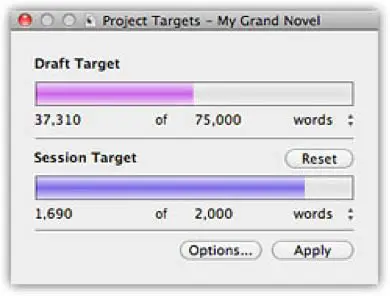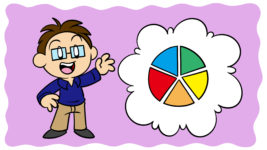The tools of a writer’s craft have constantly evolved through history, from oral storytelling, through quills and typewriters, to the modern computer.
The way that writing tools have developed you could be forgiven for thinking the next innovation in writing technology will be a new machine. In fact it’s book writing software that represents the future. Computers have grown more compact, more transportable, but it’s in how we use them that the real progress has been made.
In a world where every computer comes with basic writing software it can be tempting to think authors have everything they need, but that’s a thought that’s plagued every innovation. The ‘save’ function we take for granted was never dreamed of by those authors writing single copies of their masterworks on sheets of paper. Even now, as cloud technology moves files into a space accessible from anywhere in the world, it seems the next generation of authors will wonder how their predecessors made do with keeping their work on individual computers.
So if how we use computers is the future, what’s the next important tool for authors? The answer is dedicated book writing software.
The Iliad and the shopping list
In a world where there’s an app for everything it’s no longer necessary to use the same technology for writing a novel as you would for writing a shopping list or composing an email. Writing tools designed for a wide variety of uses might be sufficient, but they’re full of features novelists don’t need and lack many that they do.
Existing technology is more than capable of providing custom software for the task of writing a novel. As someone who loves the ever evolving role of technology in literature I’ve watched a few examples of dedicated author software come and go. Many were exciting in their own way, but none were quite good enough to declare ‘the next big thing’.
That’s no longer the case as, in the Scrivener software package, authors finally have a dedicated writing tool that brings something new to the table.
Scrivener review
Scrivener has a lot of useful features, but there are two that make it the next great tool for novelists. The first is that it’s more of a workstation than a word processor. Imagine your story research involves a few graphs, some photographs and some written documents. Usually that information would be created and stored on various different programmes, their only connection being that you keep them in the same file. With Scrivener, different types of file are stored as part of the same project – linked within the programme rather than just sharing folder space – and can be amalgamated with ease.

Multi-panel displays mean different files can be displayed alongside each other using an interface designed for passing information between the two. It’s a minor but obvious bit of convenience authors badly need. No more copying a graph from Microsoft Excel to Microsoft Word and then spending the next half an hour fixing the formatting.
What this boils down to is that Scrivener is tailored to treat written files like creative work. It includes feature such as an index card corkboard, ideal for story boarding, and an outlining tool for a clearer view of a piece’s structure. Scrivener takes a process that usually involves various computer programs, flash cards, and reams of paper and converts it to a single program designed with an appreciation for how each element fits together.

The second major innovation that Scrivener offers is its synchronicity between devices. The Mac version of the programme also works with iPads and iPhones, unshackling your project from a single device. Likewise both the Mac and Windows version of the software are designed for easy collaboration with file-sharing tools. Effectively, Scrivener becomes an entire work station – including research texts, post-its, and plotting devices – that you can access anywhere.
The appreciation for synchronicity across platforms isn’t exclusive to the drafting process; the ‘compile’ feature allows you to convert your finished document into a range of formats, whether that be to a particular academic standard or into a submission-ready manuscript. When using simple word processors converting a finished document to an ebook file is a tedious job often requiring separate software, but with Scrivener compiling your final document into ebook format is a standard option. There’s even a dedicated ‘script writing’ mode that automatically formats your work to industry standards.
The combined result of these features is a tool which is designed for producing a finished creative work rather than simply committing words to the page.
Author Appreciation
As a workspace rather than a word processor, Scrivener has a host of features that make it more author friendly. My particular favourite is the targets function, where users can set project or session specific targets for what they intend to achieve. It might not sound like much to non-writers, but every author knows there’s a huge difference between promising yourself you’ll write two thousand words in a sitting and having some form of tangible measure up on screen.

The appreciation for the user’s goals is also present in snapshot saving which allows you to keep multiple copies of the same document. Saved versions of the same file are kept in chronological order, allowing different drafts of the same story without the risk of saving over or misnaming a key draft.
There are tons of minor features that show Scrivener was designed specifically for creative work. Full screen editing is great, allowing chronic procrastinators to focus on their manuscript and nothing else. Automatic backups can be set for whenever a project is open or closed, ensuring no part ever needs to be lost. One feature that shows the software really goes that extra yard is the name generator, which allows writers to plug in various conditions (such as nationality) and produces a range of possible character names along with their meanings and history.

The right tool for the job
It’s difficult to convey how these seemingly small changes combine to produce the best dedicated writing tool on the market. What may seem like convenience becomes something more when all the minor niggles that come with a standard word processor are replaced with helpful tools and features. Scrivener is designed specifically for creative writers, with an in-depth understanding of what they are trying to achieve and the tools they need to get there.
If you already own Scrivener or want to get up to speed on using it then I’d recommend the Learn Scrivener Fast online course by Joseph Michael. We’ve also written a Learn Scrivener Fast review which you might want to check out to help you get the most out of the software. You can get a 20% discount on the course here.
Is there an iPhone app for Scrivener?
Yes, since July 2016 there is an iPhone app for Scrivener . You can find out more about it here.
Standoutbooks is committed to bringing authors up to date information on writing, publishing and marketing their work. We’ve covered everything from book trailers to author websites in an effort to give our readers every possible advantage.
Have you had any major problems with word processors, or do you write every new draft by hand? Either way I’d love to hear from you in the comments.
Scrivener: Is It The Best Book Writing Software?Click To Tweet





46 thoughts on “Scrivener Review: Is It The Best Book Writing Software?”
I LOVE Scrivener!
I wouldn’t know what to do without it. I have been using it for about a year and half and I’ve never regretted the purchase. I can’t imagine going back to using a linear program like Word or Pages.(The creative part of me get’s edgy and difficult when I try to make it move in a straight line.:)
If you are the type of writer who can sit down and write a novel from beginning to end because the story just pours out of you like a faucet, you may not need Scrivener.
But if you like to skip around in your timeline, develop back stories for your characters, track your pacing, change the sequence of your scenes, keep track of research for some technical element in your storyline, single out one particular character and pull up all their scenes to check for inconsistencies, (there are so many options I can’t begin to list them all) You will love Scrivener!
It takes a little while to learn how to customize it but it is time well spent.
Bonus: It’s great for organizing other projects too, anything from Christmas lists to weddings : )
Just a heads up to those who use the Linux OS. You can use Scrivener here.
It’s stable. I’ve used it for a while now.
Does scriviner allow for real time collaborative writing. I write my books with another person and now we use google docs, but it is very limited in many ways.
Thanks for the blog
Hi Jon, (apologies for the delayed response, I’ve only just seen this) Scrivener isn’t really designed for real time collaborative writing, you’d have to use an additional tool for the collaboration side of things.
Hi Alexander,
Firstly, thanks a lot for putting together the Scrivener Review which, by the way, it’s totally new for me. I finished writing my second book (the first one is children’s novel that never was published before).
My latest work is an specialised reading material for Health & Fitness professionals. Apart from the text, it includes tons of photos, charts and some basic graphics. As this book is the result of 2 years of research and many hours of dedication, I really need to get it right while organising the publishing process. My idea is to subdivide each chapter as a educational training package. So, here are a couple of questions :
• Is Scrivener the best option to organise my book for publishing purposes?
• As a Mac user, is it the best alternative? If not, what would suggest?
I would highly appreciate your expert opinion.
Cheers,
Will
Hi Will,
Thanks for taking the time to read the review.
Scrivener is a great tool at any stage of the writing process and I use it regularly, as a Mac user, to write all sorts of things from books to blog posts. I get the most use out of it when I use it for research and writing but there’s no reason you couldn’t use it to finalize your layout and structure.
In your case where you have already written the book you could import the text and then divide it into chapters or any other kind of structure. You are then able to move these sections around, reorder them or view certain sections together. You can also use the virtual cork board to get an overview of all sections in one place, complete with color-coded labels and summaries.
Their landing page gives you a pretty good idea of what is possible.
Hey, Alexander
Thanks a lot for your quick response.
The info provided in their “Landing Page” is definitely very handy.
It’s exactly what I need to organise, insert and edit over 600 pages of personal thoughts, references and graphic support.
In fact, i just placed my order.
Again, I highly appreciate your help.
Take care.
I have just purchased Ulysses III app, which I like a lot. I’ll take a look at Scrivener as well. thanks.
Hi, I have to write a books about programming, with few dozens of images, tables, frames and other graphical shapes, with classic wrapping option for text against images. I tried it with Word but Word sometime behavior badly with long file spiced with images that are here and there. Can your software help better?
Can the cost of scrivener be paid in euros/british pounds?
As far as I’m aware it’s only available in US$.
I have already started a project in word and I have been going for 100 pages. Would it be alright to switch to Scrivener mid-project, or should I just stick with Word?
You can absolutely switch mid-project, in Scrivener you can simply select File > Import > Files and import your Word document. This won’t change your original word document.
“The second major innovation that Scrivener offers is its synchronicity between devices. The Mac version of the programme also works with iPads and iPhones, unshackling your project from a single device. Likewise both the Mac and Windows version of the software are designed for easy collaboration with file-sharing tools. Effectively, Scrivener becomes an entire work station – including research texts, post-its, and plotting devices – that you can access anywhere.”
I wasn’t aware that Scrivener is available on the iPad. I’ve been waiting for it for ages. How were you able to access it? Does it work as well as the desktop Mac version?
Hi Troy,
The Scrivener iPad version is not available yet, however Scrivener 2.0 for the Mac has ways of syncing with existing iPad and iPhone applications to help work on the go. You can see more at the bottom of the video page here.
I have one question, essential to any journalist or book writer. It involves pagination. Practically every word processor I’ve used paginates as you write, unless the word processor allows something called “Draft mode” in Word. Let me be clear: the PUBLISHER paginates the story, not the writer. That means the publisher needs unpaginated copy from the writer. Only MS Wordpad does automatically, to my knowledge.
Paginated copy is useless to the desk in the newspaper world, in which I work: takes too long to un-paginate then re-paginate the story.
So the question is this: does Scrivener default to unpaginated copy?
It is an essential question to any writer on quick deadlines. Something the vast majority of word processors simply ignore.
You can export unpaginated text from Scrivener to rtf or txt files. I would suggest trying it to see if it suits your writing needs.
How many mb can the software handle in total? I have lots of photos and text.
Hi Bill,
Literature & latte say they have made it as robust as possible to be able to deal with all conceivable project sizes. From them directly:
The one caveat they mention is that you will need the equivalent space for backups, so if your project is 8GB, you’d need another 8GB storage.
Does this program format novels, plays, etc…to publisher and industry standards? How difficult is this to learn for those of us who are not very computer savvy and techie?
Thanks!.
Hi Daniel, you can format your manuscript however you like and there are a number of different templates you can use for novels and plays. It won’t replace typesetting software such as InDesign.
There is a learning curve, however I highly recommend Scrivener Coach as a fantastic course to help you get the most out of the software.
Alex
I am about to take the plunge with Scrivener based on this review. I have been working in Word and also Penzu if you can believe it to write my memoir.
I work here and there, I lack an overall structure, and now that I am totally changing the voice of the book, I think I need a better organizing tool.
Enter scrivener.
thanks
Dan de Angeli
Hi Dan,
I’m sure Scrivener will work for you. It does have a bit of a learning curve, so if you get stuck at any point, I can recommend Scrivener Coach to help get the most out of it.
Dear Alex
How easy is it to change Scrivener files into WORD files? I have tried to read the instructions for doing this but get lost halfway through is there an idiots guide?
By the way Scrivener is easily available in the UK iff you have Apple go to apps for writers and it will come up there I’m not sure about its availability for windos though.
Thank you for some very interesting information your comment and peopls’ question have helped me a lot.
Cynthia
Hi Cynthia,
On every screen, just above the Compile, Save & Close and Save buttons, there’s a Compile For pull down menu. You can select Word and have it save as a .doc automatically.
There’s also a very useful guide here.
Thank you so much you have saved me so much time. The link you gave is very good thank you again
Cynthiax
Alex,
I would like to understand why many people said that they love to use Scrivener for books writing but they still need Word to finish their works. Could you please clarify this?
Thank a lot.
Vinh
I thought I’d try Scrivener, but I’m stuck at the very first hurdle. When I import a project, whether it’s in .docx or .rtf, it imports as a series of narrow columns. There is nothing I can do to make the text stretch across the page. So it’s impossible to work with. I tried copying and pasting into a new text document in a new project. The same result. Any ideas?
Hi Lynne, that sounds a bit strange. I’d suggest checking out Scrivener technical support. I hope you get your problem sorted out.
I’ve actually given up on the program.
I don’t write my novels the way Scrivener wants me to. I start at the beginning and write all the way through. There’s little reason for me to shift scenes around, because I write a synopsis before I start, so I know what goes where. If I do decide to shuffle, there’s good old copy and paste. Then I have to write to suit, and having everything in one document makes that task much easier.
The weird formatting was only the first problem. It’s so counter-intuitive that I was spending far too much time looking things up, things I know where to find in a word processing program. Total word count, tweaking Styles, autocorrect (why is it buried so deeply, and why isn’t there a keyboard shortcut?)
The distraction-free mode – wasn’t. Even when I blacked out the background, I kept wondering how to do stuff.
There is very little opportunity to tweak and make Scrivener my own, adapt it to the way I write, whereas I’ve been able to do that with word processors.
Speaking of which, the actual word processor inside Scrivener is actually quite nice, but I can’t give up all the other things just to use it.
If I wanted to do something, I’d google for it, and come up with nothing, or pages of people with contradictory ideas.
I did think of using it for a drafting tool, but what made me abandon it completely was the Compile tool. It’s awful. Honestly awful, and it produces a pile of stuff I can’t use anywhere else. The italics were rendered as a different font, and in bold, and the styling was inconsistent – if it’s tweaked, it doesn’t affect the whole document. In the end, I copied and pasted what I’d written in Scrivener (precious little, I was wasting far too much time playing and looking stuff up) into a new Word document, rather than spending hours on something I was by then convinced I was only going to use once.
Word processing programs do have their faults, but at least they work on the same basic principles, so it’s not hard to go from one to the other. I write in Word on my main computer, and use LibreOffice when I’m on the road, and the two programs compliment each other.
Sorry, Scrivener, I did give it a good try, but it just doesn’t work for me.
Hi Lynne,
Thanks for sharing your experience, I’m sure others will find it helpful. You should be able to get a refund from Scrivener if it doesn’t work for you.
I did a course with Scrivener Coach which really helped me get up and running and which I would recommend to anyone else struggling with the software.
I’ve decided to keep the program, just for the word processor, which is a good one. I can’t edit with it, but it’s one of the best I’ve discovered for composition, and I can put it full screen, (not the “no distractions mode” just getting rid of the fussy bars on either side!). I’m transitioning from Office, merely because of the price, which is little short of extortionate, so it’s been a rocky road!
If I had a suggestion, it would be to make the word processor more Word-like, simply because that is what people are used to. And add macro capability. And Track Changes, because I use that to make notes in the text, as well as editing. But making the interface more familiar would make the transition much smoother. People could start by using the processor, then introduce the other things gradually and as they need them.
hi!
I have a bunch of PDF scanned in files as well as MS Word files that I received. I am suppose to use it all to create more of a textbook with it. I will have to put images on as well. I will need a blank side bar on the textbook for students to take notes, as well as foot notes on certain words or phrases.
I am constantly on the road and I will only have my IPAD with me. I have a laptop as well but mostly will not have it with me when I travel.
Will Scrivener work for my needs, since I also want to publis hardcopies and also as an e-book?
Your honoust advise will be appreciated.
Scrivener is more useful for the writing than the formatting of books. Also, there isn’t currently an iOS version so if you are mainly relying on your iPad then it might not be ideal for your needs.
G’day,
I have written a rough draft of a fantasy novel set in a completely made up world with maps, weather, graphic timeline, history, social events and a completely different calendar. This was all done with multiple files and various programs.
To say it was cumbersome would be putting it lightly, at 200 000 words which I had done in word and open office it had become near impossible to keep track of all the different aspects of this novel, especially fitting it all into chronological order on my timeline along with travel times and distances on my maps.
With the tools scrivener offers I breathed a great sigh of relief when I imported my work and broke it down into chapters with all my own tools, like maps and such, close at hand. I no longer had my head full of things I needed to remember all the time and instead got on with my writing undistributed.
(I write in no particular order of time, this book arose from an example I wrote to help another writer which then became a book through popular demand by those around me to finish the story and therefore was totally unplanned. Scrivener handles the problems this created perfectly.)
I write on two computers, one a desktop and one mobile and so transfer between the two. This was becoming a nightmare before scrivener when I had multiple files and I was constantly worried I would overwrite the wrong ones, but now it is so simple I can juggle between the two using a flash drive as common ground.
I am really looking forward to the next draft, filing in the details and editing using scrivener.
I am writing an autobiography of the life of my wife and I. I plan to have hard cover books printed for our family. It is about 180 pages of narrative, 11 pt type, and I want to add about 200-300 photos that are embedded in the narrative, anchored to the text and text wrapped around photos. I have completed the narrative and have started to incorporate the photos. I am using Serif PagePlus X8 software and I have run into problems incorporating that number of photos embedded in the text. The software doesn’t seem to be able to handle the quantity of photos. I can probably add photos at the end of each chapter but I prefer to embed them in the text. Would Scrivener do this job? Any comments on this or any other software that would allow me to proceed would be greatly appreciated.
Maybe Scribus (https://www.scribus.net/) is a solution if you don’t have a solution yet. It’s a free to use piece of Desktop Publishing Software (as Serif PagePlus X8 is).
I haven’t had those kind of documents yet, but used it for smaller documents that where a pain in the ass with LibreOffice.
The enthusiasm of these testimonials is quite impressive. It’s typical of marketing departments not to share any endorsements that profess anything less than 100% praise. This is why I almost never put any credence into what I read in the way of testimonials.
Here’s what I wrote on Literature and Latte’s FB page today. For some reason, it doesn’t appear but I kept a copy of the post with the expectation it would be deleted and blocked.
FB POST ___________________________________________________
Scrivener followers number 42K and growing every day. The success of L&L in their development has been impressive. Listening to users has apparently contributed to this success.
But unlike almost all of the 42K users following on Facebook, I hope no one will be offended if I share my experience before L&L customer service deletes this post and blocks me from this FB page.
L&L dismissive attitude may be tied to the low price. This growth comes the disturbing cost of irresponsibility toward their promises. Hockey stick growth curbs happen when companies become too successful. I would not blame the CS team for their dismissive attitude. As with many web-based companies, providing a human voice in real-time via chat or voice is too expensive.
The CS managers and their board members forget that their success depends on their customers. As the owner of a small consulting first, I’ve never forgotten that my clients enable our team to be successful.
We would never make a customer wait days for a response to a sincere, specific and articulate inquiry. More importantly, we would carefully read a customer’s email so that we can respond to each and every point. Not simply read the subject line, the cut and paste what the boss instructed them to day. Pick a response that most closely matches, paste that non-sequitur response, add a disingenuous phrase– such as “we thank you and we’re so glad that we could help you”. Please let us know how else we can be of disservice.
The key point is that after a writer user has paid their nominal fee for the software. Buy it. It’s less than a lunch for two. But the learning curve is high. Even when you hire a training specialist at ten times that price, you also have to consider if your learning curve investment will be worth it. I’ve found “time saving, long learning curve” software to be a sophisticated form of writer procrastination.
Many writers, in some fleeting moments, wrote our best work when putting away all of our notes cards and file folders. We centered our selves with mindfulness technique of choice. We find our inner voice. We channel what we’ve read and remember. If we are skillful, were enter what Mihaly Csikszentmihalyi describes in his work as the psychological concept of flow.
https://en.wikipedia.org/wiki/Mihaly_Csikszentmihalyi
When such a useful product is priced so affordable, the what I call the “Comcast Effect”. Comcast’s customer service has prompted customers to take the time to vent on a number of web pages. Other than in public policy and political discourage on the web, there no wrath that a customer scorned by customer service. The term customer service has become an oxymoron in an Orwellian sense.
The slogan “We care!” is true for a CS departments. Unfortunately for the users, the care is directed toward L&L and not where it would be most useful.
In closing, my experience has been L&L suggests that future users watch out for low prices. Low-cost support is worth what you pay for it.
— Rick
Rick,
What are you trying to say here? I read trough the post, but it’s not clear to me what you’re trying to tell us or what you’re trying to achieve.
I have just participated for the first time in the National novel writing month channel.
As a “winner” I believe I can claim a discount on the price of Scrivener.
I’m of a certain age, 60, therefore have not been weaned on computer technology but have a good working knowledge of Word.
as I have never written a novel before, I think I would like to have a go at scrivener with discount… but there are several versions. Which is the simplest. In your opinion is it worth an old lady trying to get to grips with it. Or you think the learning ‘curve’ will be too steep for me with my arthritis and bad knee.
Regards.
Hi Marie,
Congratulations on finishing NaNoWriMo!
Scrivener certainly has a learning curve, however I think if you are comfortable with Word then you would certainly be able to learn how to use Scrivener.
I can recommend this excellent training on how to get the most out of Scrivener:
//www.standoutbooks.com/go/scrivener-coach/
I absolutely LOVE Scrivener! I have been using it for a couple of years and it is now the only tool I use to write these days, perhaps with the exception of Scapple, Literature & Latte graphic tool for organising thoughts and ideas. My only regret is that I have never managed to get it to work on my iOS devices, in spite of trying for weeks, when I first installed it on my iPad and iPhone.
Awesome review, I agree so much with a lot of what you say. I find the word count target mode to be really powerful and motivational. It’s a lot harder to slack off from working when there is a number staring at you 😉
If anyone is on the fence about getting Scrivener, there are a bunch of discounts and coupons available at – http://scrivenerville.com/. It also has some cool templates and other stuff which can help people reduce their learning curve and get started.
I know a lot of people are starting to switch over to Vellum for some parts of their writing and publishing process, but for me, I still think Scrivener has the best all in one capability.
I have already written a book using iBooks Author. I am about to add new material, revise the chapter order, correct spelling, include new photos and documents, and publish it again. I see that there is a capability to export to iBooks Author, but can I import iBooks Author (my book) into Scrivener – coping formats, photos, etc. to a Scrivener generated copy? Appreciate and advice. Thanks in advance. jn
Atomic Scribbler is similar in some ways to scrivener, but not as complicated. https://www.atomicscribbler.com/ I’ve been using it for my book series. It’s free software for windows – an optional paid addon, SmartEdit, provides help with self editing.